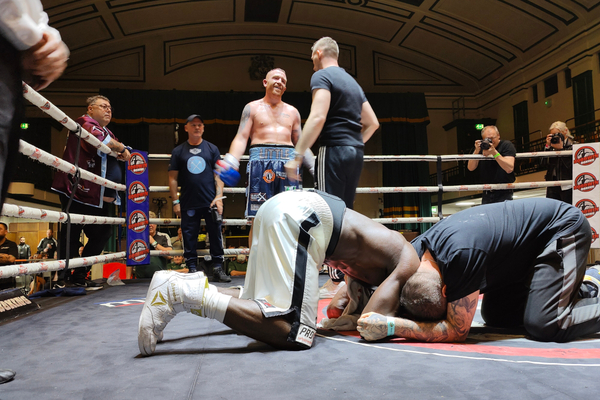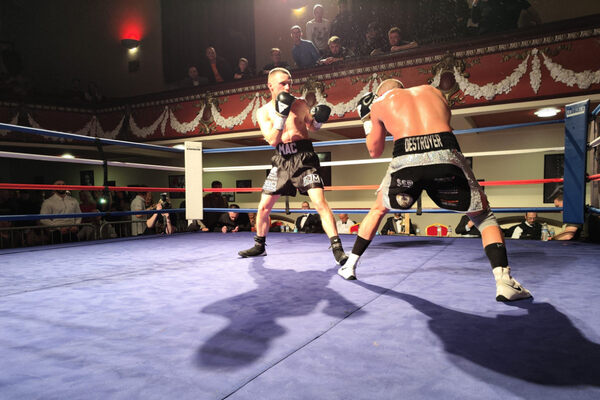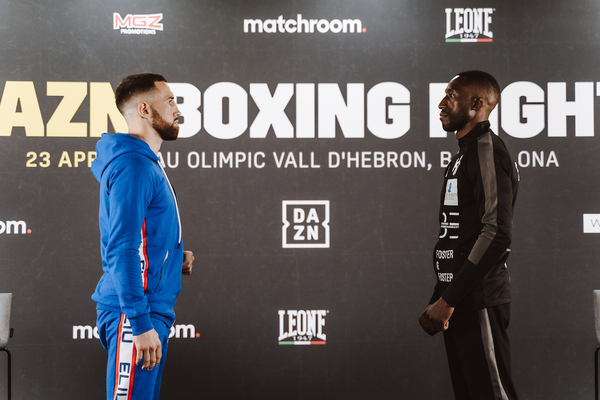Lamon Brewster and the Medical Mess
Brewster's biggest win came against Klitschko
By Thomas Hauser
It has been widely reported that Lamon Brewster suffered a detached retina in his left eye in the first round of his April 1st WBO heavyweight title fight against Sergei Liakhovich in Cleveland, Ohio. However, multiple sources tell SecondsOut that these reports don't tell the whole story. Yes, Brewster suffered a detached retina during the Liakhovich fight. But his eye was injured BEFORE the bout. He underwent laser eye surgery in Los Angeles several weeks before the fight and the eye continued to trouble him.
Surgery of this nature is nothing new for Brewster. Sources also say that he had laser eye surgery for a retinal tear several weeks before his April 10, 2004, fight against Wladimir Klitschko. The decision to proceed with the Klitschko bout was made because it was perceived as the opportunity of a lifetime and Lamon was given a medical opinion that his surgically-repaired eye would not be a problem. The decision to proceed with Brewster-Liakhovich is believed to have been made in part because of Lamon's desire to fulfill his contractual obligations to Don King so he could move to a new promoter.
Bernie Profato (executive director of the Ohio State Athletic Commission) says that boxers who compete in Ohio must have an opthalmological examination within one year of fighting in the state. The one-year requirement opens the door to abuse. A fighter could pass an eye test, be injured months later, and not be tested again prior to his next fight. However, with Brewster-Liakhovich, that point is moot. According to Profato, Brewster underwent an opthalmological examination eight days before the fight.
"I have the form in front of me," Profato told SecondsOut on Thursday, April 6th. "We use the same form they use in Nevada. Brewster was tested in Vero Beach, Florida, on March 24, 2006. The doctor gave him one of those tests where they put drops in your eyes and checked the box that says, 'I do not find a condition that would prevent him from being licensed as a professional boxer.'"
But something went wrong somewhere in the system. Who knew what and when did they know it? Government regulators should be interested in answers to these questions.
Meanwhile, on the same night that Lamon Brewster lost his belt to Sergei Liakhovich, Joe Mesi returned to the ring against 41-year-old Ron Bellamy in Guaynabo, Puerto Rico. It was Mesi's first fight since suffering a subdural hematoma in a ten-round victory over Vassiliy Jirov on March 3, 2004, in Las Vegas.
When reports that Mesi had suffered multiple brain bleeds first surfaced, he and his camp denied it and said that Joe had suffered only a concussion. Faced with irrefutable evidence to the contrary, they came clean. To its credit, the Nevada State Athletic Commission placed Mesi on permanent medical suspension. Under federal law, every jurisdiction in the United States was obligated to honor that suspension.
Then, on December 19, 2005, a state court judge in Nevada overturned Mesi's suspension on the dubious grounds that the Nevada commission lacks the authority to keep a fighter on medical suspension after the expiration of his license. In Nevada, fighter licenses expire on December 31st of each year. That means, even if Nevada chooses not to license Mesi in the future, any jurisdiction that wants him can have him.
The judge's reasoning was tortured at best. Under the illogic of the court's ruling, if Zuri Lawrence had been knocked unconscious by Calvin Brock on December 28th, he would have been free to fight in another state four days later.
The State of Nevada seemed happy to be rid of the Mesi matter and did not appeal the judge's ruling. "It basically takes a lot of teeth out of the Ali Act," Keith Kizer (the chief deputy attorney general who handled the case) said afterward. "It takes away Congress's ability to prevent a fighter who has not proven he's fit to fight from going elsewhere. But the adverse impact is on the federal law. It's not on the state law or on the commission."
On March 6th, Tim Lueckenhoff (president of the Association of Boxing Commissions) sent a memorandum on the Mesi matter to all ABC members. Taking note of the judge's ruling, Lueckenhoff decreed, "If your commission issues a medical suspension to a boxer and the medical suspension is terminated only as a result of the expiration of that boxer's license and, as a result, you are required to lift the medical suspension, the ABC hereby directs that the following language be forwarded to Fight Fax: 'Medical suspension terminated due to expiration of license. Not medically cleared by [name of boxing commission].'"
Lueckenhoff's memorandum also directed, "If you discover such language on a Fight Fax report regarding a boxer seeking a license from your commission, you are directed to contact the boxing commission which imposed the medical suspension; determine the basis of the medical suspension; and carefully consider all of the facts and circumstances attendant to the said medical suspension in deciding to grant or deny the boxer a license."
However, there will always be states willing to license Mesi. After all, light-heavyweight Robert Muhammad, who suffered a subdural hematoma after being knocked out in 1999, was suspended for 18 months and then allowed to return to the ring. He has lost 22 of his last 23 fights in North Carolina, South Carolina, Florida, Mississippi, Georgia, Illinois, Massachusetts, and Louisiana.
As for Bellamy, he lost a unanimous eight-round decision to Mesi. That was an improvement over his last three fights, given the fact that he was carried from the ring on a stretcher following two of them.
All of this comes at a time when boxing desperately needs higher medical standards. The American Association of Professional Ringside Physicians could play a constructive role in that endeavor. But instead, the AAPRP seems more intent on expanding its power. Currently, the group is pushing hard to become the only official certifying authority for ring physicians throughout the United States and hopes to be the controlling authority for any medical data bank that might be established pursuant to federal law.
Tim Leuckenhoff and Greg Sirb (past president of the Association of Boxing Commissions) noted last year that the AAPRP is essentially a trade association for doctors; not a governmental body. That view is echoed by Hugo Spindola (executive deputy commissioner and general counsel to the New York State Athletic Commission), who says, "The AAPRP represents its physicians. It does good work; but in large measure, it's a lobbying organization. Now it's trying to cover territory that's within the realm of government regulation, and that's just not appropriate. Also, as a matter of law, the New York State Athletic Commission is responsible for certifying ring physicians in New York, and we don't have the authority to turn that certification over to anyone. It can't be done."
Meanwhile, boxing awaits the report of the advisory committee on boxer health and safety formed by the Nevada State Athletic Commission last September after the deaths of Martin Sanchez and Leavander Johnson. The committee's findings were originally due by April 1st of this year.
On February 3, 2006, at one of two public meetings held by the committee, Dr. Michael Seiff (the neurologist appointed to the committee) asked if fighters were tested to determine if they purposefully dehydrated themselves to make weight. Seiff's question (which raised eyebrows regarding his knowledge of boxing) came one day after NSAC chairman Skip Avensino appeared on the Jon Ralston Show. Ralston asked Avensino about phony medical examinations, and Avensino said that commission doctors could order new tests if they thought something was amiss. But the two doctors who raised the issue of phony medicals in Nevada (Flip Homansky and Margaret Goodman) were forced off the commission last year.
The above issues highlight the slipshod manner in which medical care for fighters is treated in the United States. As Larry Merchant observed recently, "Shame is a concept that is beyond the conception of most people in boxing."
Thomas Hauser can be reached by email at thauser@rcn.com.
It has been widely reported that Lamon Brewster suffered a detached retina in his left eye in the first round of his April 1st WBO heavyweight title fight against Sergei Liakhovich in Cleveland, Ohio. However, multiple sources tell SecondsOut that these reports don't tell the whole story. Yes, Brewster suffered a detached retina during the Liakhovich fight. But his eye was injured BEFORE the bout. He underwent laser eye surgery in Los Angeles several weeks before the fight and the eye continued to trouble him.
Surgery of this nature is nothing new for Brewster. Sources also say that he had laser eye surgery for a retinal tear several weeks before his April 10, 2004, fight against Wladimir Klitschko. The decision to proceed with the Klitschko bout was made because it was perceived as the opportunity of a lifetime and Lamon was given a medical opinion that his surgically-repaired eye would not be a problem. The decision to proceed with Brewster-Liakhovich is believed to have been made in part because of Lamon's desire to fulfill his contractual obligations to Don King so he could move to a new promoter.
Bernie Profato (executive director of the Ohio State Athletic Commission) says that boxers who compete in Ohio must have an opthalmological examination within one year of fighting in the state. The one-year requirement opens the door to abuse. A fighter could pass an eye test, be injured months later, and not be tested again prior to his next fight. However, with Brewster-Liakhovich, that point is moot. According to Profato, Brewster underwent an opthalmological examination eight days before the fight.
"I have the form in front of me," Profato told SecondsOut on Thursday, April 6th. "We use the same form they use in Nevada. Brewster was tested in Vero Beach, Florida, on March 24, 2006. The doctor gave him one of those tests where they put drops in your eyes and checked the box that says, 'I do not find a condition that would prevent him from being licensed as a professional boxer.'"
But something went wrong somewhere in the system. Who knew what and when did they know it? Government regulators should be interested in answers to these questions.
Meanwhile, on the same night that Lamon Brewster lost his belt to Sergei Liakhovich, Joe Mesi returned to the ring against 41-year-old Ron Bellamy in Guaynabo, Puerto Rico. It was Mesi's first fight since suffering a subdural hematoma in a ten-round victory over Vassiliy Jirov on March 3, 2004, in Las Vegas.
When reports that Mesi had suffered multiple brain bleeds first surfaced, he and his camp denied it and said that Joe had suffered only a concussion. Faced with irrefutable evidence to the contrary, they came clean. To its credit, the Nevada State Athletic Commission placed Mesi on permanent medical suspension. Under federal law, every jurisdiction in the United States was obligated to honor that suspension.
Then, on December 19, 2005, a state court judge in Nevada overturned Mesi's suspension on the dubious grounds that the Nevada commission lacks the authority to keep a fighter on medical suspension after the expiration of his license. In Nevada, fighter licenses expire on December 31st of each year. That means, even if Nevada chooses not to license Mesi in the future, any jurisdiction that wants him can have him.
The judge's reasoning was tortured at best. Under the illogic of the court's ruling, if Zuri Lawrence had been knocked unconscious by Calvin Brock on December 28th, he would have been free to fight in another state four days later.
The State of Nevada seemed happy to be rid of the Mesi matter and did not appeal the judge's ruling. "It basically takes a lot of teeth out of the Ali Act," Keith Kizer (the chief deputy attorney general who handled the case) said afterward. "It takes away Congress's ability to prevent a fighter who has not proven he's fit to fight from going elsewhere. But the adverse impact is on the federal law. It's not on the state law or on the commission."
On March 6th, Tim Lueckenhoff (president of the Association of Boxing Commissions) sent a memorandum on the Mesi matter to all ABC members. Taking note of the judge's ruling, Lueckenhoff decreed, "If your commission issues a medical suspension to a boxer and the medical suspension is terminated only as a result of the expiration of that boxer's license and, as a result, you are required to lift the medical suspension, the ABC hereby directs that the following language be forwarded to Fight Fax: 'Medical suspension terminated due to expiration of license. Not medically cleared by [name of boxing commission].'"
Lueckenhoff's memorandum also directed, "If you discover such language on a Fight Fax report regarding a boxer seeking a license from your commission, you are directed to contact the boxing commission which imposed the medical suspension; determine the basis of the medical suspension; and carefully consider all of the facts and circumstances attendant to the said medical suspension in deciding to grant or deny the boxer a license."
However, there will always be states willing to license Mesi. After all, light-heavyweight Robert Muhammad, who suffered a subdural hematoma after being knocked out in 1999, was suspended for 18 months and then allowed to return to the ring. He has lost 22 of his last 23 fights in North Carolina, South Carolina, Florida, Mississippi, Georgia, Illinois, Massachusetts, and Louisiana.
As for Bellamy, he lost a unanimous eight-round decision to Mesi. That was an improvement over his last three fights, given the fact that he was carried from the ring on a stretcher following two of them.
All of this comes at a time when boxing desperately needs higher medical standards. The American Association of Professional Ringside Physicians could play a constructive role in that endeavor. But instead, the AAPRP seems more intent on expanding its power. Currently, the group is pushing hard to become the only official certifying authority for ring physicians throughout the United States and hopes to be the controlling authority for any medical data bank that might be established pursuant to federal law.
Tim Leuckenhoff and Greg Sirb (past president of the Association of Boxing Commissions) noted last year that the AAPRP is essentially a trade association for doctors; not a governmental body. That view is echoed by Hugo Spindola (executive deputy commissioner and general counsel to the New York State Athletic Commission), who says, "The AAPRP represents its physicians. It does good work; but in large measure, it's a lobbying organization. Now it's trying to cover territory that's within the realm of government regulation, and that's just not appropriate. Also, as a matter of law, the New York State Athletic Commission is responsible for certifying ring physicians in New York, and we don't have the authority to turn that certification over to anyone. It can't be done."
Meanwhile, boxing awaits the report of the advisory committee on boxer health and safety formed by the Nevada State Athletic Commission last September after the deaths of Martin Sanchez and Leavander Johnson. The committee's findings were originally due by April 1st of this year.
On February 3, 2006, at one of two public meetings held by the committee, Dr. Michael Seiff (the neurologist appointed to the committee) asked if fighters were tested to determine if they purposefully dehydrated themselves to make weight. Seiff's question (which raised eyebrows regarding his knowledge of boxing) came one day after NSAC chairman Skip Avensino appeared on the Jon Ralston Show. Ralston asked Avensino about phony medical examinations, and Avensino said that commission doctors could order new tests if they thought something was amiss. But the two doctors who raised the issue of phony medicals in Nevada (Flip Homansky and Margaret Goodman) were forced off the commission last year.
The above issues highlight the slipshod manner in which medical care for fighters is treated in the United States. As Larry Merchant observed recently, "Shame is a concept that is beyond the conception of most people in boxing."
Thomas Hauser can be reached by email at thauser@rcn.com.
SecondsOut Weekly Newsletter
Permission Statement
We would like to ask for your permission to process your data so we can send you the latest news and trending stories in boxing.
If you accept, we will process your data to fulfil this purpose.
If you accept, we will process your data to fulfil this purpose.
Accept
Cancel
Results
© 2000 - 2018 Knockout Entertainment Ltd & SecondsOut.com
This site uses cookies, You can manage your preferences by clicking cookie settings, or simply accept to gain the full experience.



